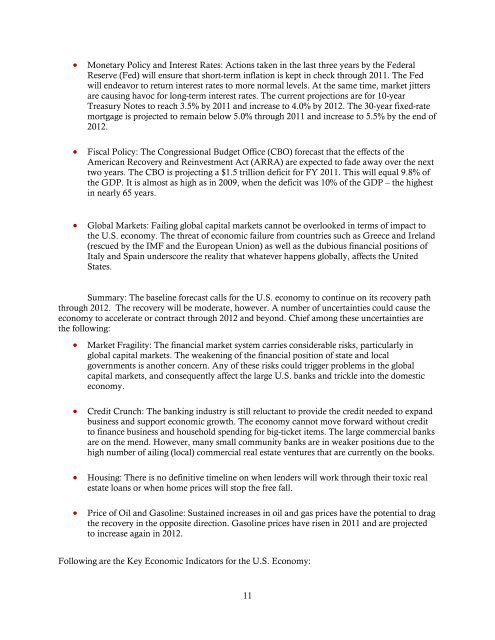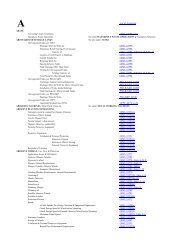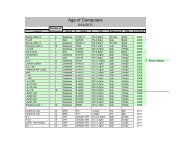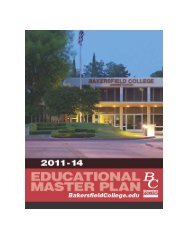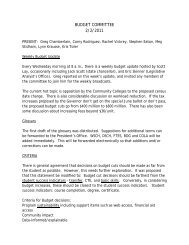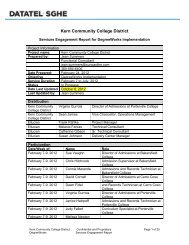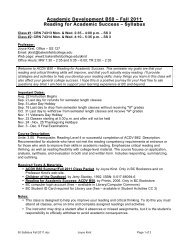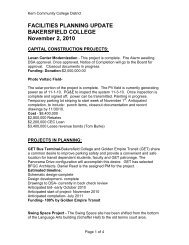Addendum with evidence (8.2 MB) - Accreditation - Bakersfield ...
Addendum with evidence (8.2 MB) - Accreditation - Bakersfield ...
Addendum with evidence (8.2 MB) - Accreditation - Bakersfield ...
Create successful ePaper yourself
Turn your PDF publications into a flip-book with our unique Google optimized e-Paper software.
• Monetary Policy and Interest Rates: Actions taken in the last three years by the Federal<br />
Reserve (Fed) will ensure that short-term inflation is kept in check through 2011. The Fed<br />
will endeavor to return interest rates to more normal levels. At the same time, market jitters<br />
are causing havoc for long-term interest rates. The current projections are for 10-year<br />
Treasury Notes to reach 3.5% by 2011 and increase to 4.0% by 2012. The 30-year fixed-rate<br />
mortgage is projected to remain below 5.0% through 2011 and increase to 5.5% by the end of<br />
2012.<br />
• Fiscal Policy: The Congressional Budget Office (CBO) forecast that the effects of the<br />
American Recovery and Reinvestment Act (ARRA) are expected to fade away over the next<br />
two years. The CBO is projecting a $1.5 trillion deficit for FY 2011. This will equal 9.8% of<br />
the GDP. It is almost as high as in 2009, when the deficit was 10% of the GDP – the highest<br />
in nearly 65 years.<br />
• Global Markets: Failing global capital markets cannot be overlooked in terms of impact to<br />
the U.S. economy. The threat of economic failure from countries such as Greece and Ireland<br />
(rescued by the IMF and the European Union) as well as the dubious financial positions of<br />
Italy and Spain underscore the reality that whatever happens globally, affects the United<br />
States.<br />
Summary: The baseline forecast calls for the U.S. economy to continue on its recovery path<br />
through 2012. The recovery will be moderate, however. A number of uncertainties could cause the<br />
economy to accelerate or contract through 2012 and beyond. Chief among these uncertainties are<br />
the following:<br />
• Market Fragility: The financial market system carries considerable risks, particularly in<br />
global capital markets. The weakening of the financial position of state and local<br />
governments is another concern. Any of these risks could trigger problems in the global<br />
capital markets, and consequently affect the large U.S. banks and trickle into the domestic<br />
economy.<br />
• Credit Crunch: The banking industry is still reluctant to provide the credit needed to expand<br />
business and support economic growth. The economy cannot move forward <strong>with</strong>out credit<br />
to finance business and household spending for big-ticket items. The large commercial banks<br />
are on the mend. However, many small community banks are in weaker positions due to the<br />
high number of ailing (local) commercial real estate ventures that are currently on the books.<br />
• Housing: There is no definitive timeline on when lenders will work through their toxic real<br />
estate loans or when home prices will stop the free fall.<br />
• Price of Oil and Gasoline: Sustained increases in oil and gas prices have the potential to drag<br />
the recovery in the opposite direction. Gasoline prices have risen in 2011 and are projected<br />
to increase again in 2012.<br />
Following are the Key Economic Indicators for the U.S. Economy:<br />
11


